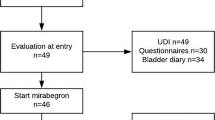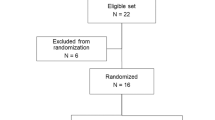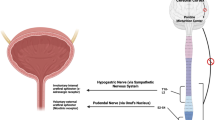Abstract
The aim of our study was to investigate the effect of duloxetine on urethral function and sphincter ultrasound morphology in 54 women, who were referred to a urogynecology unit, with urodynamic stress incontinence. All completed a King’s Health Questionnaire and a patient global assessment of improvement (PGI-I) question and underwent urethral pressure profilometry, measurement of urethral retro-resistance pressure (URP), and ultrasound of the striated urethral sphincter. The investigations were repeated after 8 weeks of duloxetine 40 mg twice daily in 36 women who continued the medication. After 8 weeks of duloxetine, the mean URP increased significantly compared to baseline (53.8 to 60.8 cm H2O; p = 0.001), and sphincter thickness was significantly higher (1.8 to 2.0 mm; p < 0.001). There was a significant increase in the maximum urethral closure pressure (MUCP) (52.7 to 59.2 cm H2O; p = 0.006) but not of functional urethral length. Subanalysis of responders (improved on duloxetine) showed a significant increase in URP (50.3 to 59.1 cm H2O; p = 0.001), sphincter thickness (1.7 to 2.1 mm; p < 0.001), and MUCP (50.2 to 58.1 cm H2O; p = 0.03). These changes were not seen in nonresponders. This study has demonstrated objective changes in urethral ultrasound morphology and function after duloxetine therapy, which relate to improved continence. A larger longer term study is required to assess if these changes persist over time. In summary, duloxetine therapy for urodynamic stress incontinence results in an increase in urethral closure pressure, URP measurement, and urethral striated sphincter thickness.
Similar content being viewed by others
References
Hannestad YS, Rortveit G, Snadvik, Hunskaar S (2000) A community based epidemiological survey of female urinary incontinence: the Norwegian EPINCONT study. J Clin Epidemiol 53:1150–1157
Minassian VA, Drutz HP, Al-Badr A (2003) Urinary incontinence as a worldwide problem. Int J Gynecol Obstet 82:327–328
Kinchen KS, Burgio K, Diokno AC, Fultz NH, Bump RC (2003) Burden of stress urinary incontinence for community-dwelling women. Am J Obstet Gynecol 189:1275–1282
Hunskaar S, Lose G, Sykes D, Voss S (2004) The prevalence of urinary incontinence in women in four European countries. BJU Int 93:324–330
Largo-Janssen T, van Weel C (1998) Long-term effect of treatment of female incontinence in general practice. Br J Gen Pract 48:1735–1738
Wilson PD, Bo K, Hay-Smith J et al (2002) Conservative treatment in women. In: Abrams P, Khoury S, Wein A (eds) Incontinence, 2nd edn. Health Publications, Plymouth, UK, pp 573–624
Pesce F (2004) Current management of stress urinary incontinence. BJU Int 94(Suppl 1):8–13
Thor KB, Katofiasc MA (1995) Effects of duloxetine, a combined serotonin and norepinephrine reuptake inhibitor on central neural control of lower urinary tract function in the chlorase-anesthetised female cat. J Pharmacol Exp Ther 274:1014–1024
Danuseer H, Bemis K, Thor KB (1995) Pharmacological analysis of the noradrenergic control of central sympathetic and somatic reflexes controlling the lower urinary tract in the anesthetized cat. J Urol 274:820–825
Norton PA, Zinner NR, Yalcin I, Bump RC (2002) Duloxetine versus placebo in the treatment of stress urinary incontinence. Am J Obstet Gynecol 187:40–48
Dmochowski RR, Miklos JR, Norton PA, Zinner NR, Yalcin I, Bump RC (2003) Duloxetine versus placebo for the treatment of North American women with stress urinary incontinence. J Urol 170:1259–1263
Millard RJ, Moore K, Rencken R, Yalcin I, Bump RC (2004) Duloxetine vs placebo in the treatment of stress urinary incontinence: a four continent randomized clinical trial. BJU Int 92:311–318
van Kerrebroeck P, Abrams P, Lange R et al (2004) Duloxetine versus placebo in the treatment of European and Canadian women with stress urinary incontinence. BJOG 111:249–257
Cardozo L, Drutz HP, Baygani SK, Bump RC (2004) Pharmacological treatment of women awaiting surgery for stress urinary incontinence. Obstet Gynecol 104:511–519
Kelleher CJ, Cardozo LD, Khullar V, Salvatore S (1997) A new questionnaire to assess the quality of life of urinary incontinent women. Br J Obstet Gynaecol 104:1374–1379
Guy W (1976) EGDEU assessment manual for psychopharmacology. Rockville (MD): National Institute of Mental Health. US Department of Health, Education and Welfare, pp 218–222
Yalcin I, Bump RC (2003) Validation of two global impression questionnaires for incontinence. Am J Obstet Gynecol 189:98–101
Slack M, Culligan P, Tracey M, Hunisker K, Patel B, Sumeray M (2004) Relationship of urethral retro-resistance pressure to urodynamic measurements and incontinence severity. Neurourol Urodyn 23:109–114
Slack M, Tracey M, Hunsicker K, Godwin A, Patel B, Sumeray M (2004) Urethral retro-resistance pressure: a new clinical measure of urethral function. Neurourol Urodyn 23(7):656–671
Hilton P, Stanton SL (1983) Urethral pressure measurement by microtransducer: the results in symptom-free women and in those with genuine stress incontinence. Br J Obstet Gynaecol 90:919–933
Abrams P, Cardozo L, Fall M, Griffiths D, Rosier P, Ulmsten U et al (2002) The standardization of terminology of lower urinary tract function: report from the standardization sub-committee of the International Continence Society. Neurourol Urodyn 21:167–178
Boy S, Reitz A, Wirth B, Karsenty G, Knapp P, Schurch B (2005) Facilitatory neuromodulative effect of duloxetine on urethral sphincter motor neurones in healthy females. Eur Urol Suppl 4:253, Abstract 998
Bump RC, Benson JT, Brubaker L et al (2004) Biomechanical and electrophysiological effects of duloxetine in women with stress urinary incontinence. Neurourol Urodynam 23, Abstract 269
Athanasiou S, Khullar V, Boos K, Salvatore S, Cardozo L (1999) Imaging the urethral sphincter with three-dimensional ultrasound. Obstet Gynecol 94:295–301
Acknowledgments
Dr. Stavros Athanasiou and Dr. Vik Khullar have received speaker’s fee for participating as invited speakers at symposia supported by Boehringer Ingelheim.
Author information
Authors and Affiliations
Corresponding author
Rights and permissions
About this article
Cite this article
Athanasiou, S., Chaliha, C., Digesu, G.A. et al. The effects of duloxetine on urethral function and sphincter morphology. Int Urogynecol J 18, 763–767 (2007). https://doi.org/10.1007/s00192-006-0230-7
Received:
Accepted:
Published:
Issue Date:
DOI: https://doi.org/10.1007/s00192-006-0230-7




